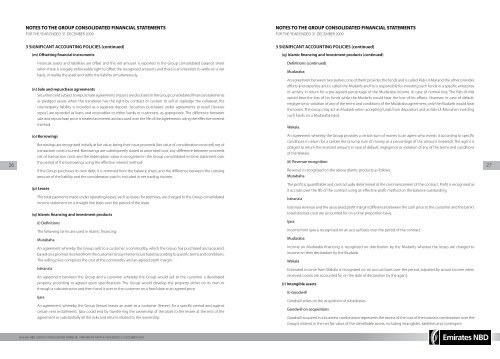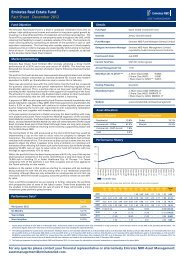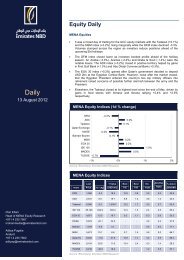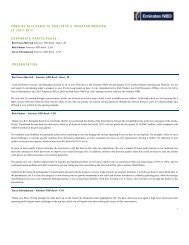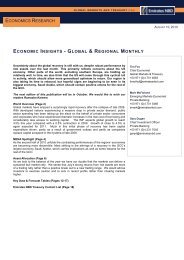Where the world comes to bank - Emirates NBD
Where the world comes to bank - Emirates NBD
Where the world comes to bank - Emirates NBD
You also want an ePaper? Increase the reach of your titles
YUMPU automatically turns print PDFs into web optimized ePapers that Google loves.
NOTES TO THE GROUP CONSOLIDATED FINANCIAL STATEMENTS<br />
FOR THE YEAR ENDED 31 DECEMBER 2009<br />
3 SIGNIFICANT ACCOUNTING POLICIES (continued)<br />
(m) Offsetting financial instruments<br />
Financial assets and liabilities are offset and <strong>the</strong> net amount is reported in <strong>the</strong> Group consolidated balance sheet<br />
when <strong>the</strong>re is a legally enforceable right <strong>to</strong> offset <strong>the</strong> recognised amounts and <strong>the</strong>re is an intention <strong>to</strong> settle on a net<br />
basis, or realise <strong>the</strong> asset and settle <strong>the</strong> liability simultaneously.<br />
(n) Sale and repurchase agreements<br />
Securities sold subject <strong>to</strong> repurchase agreements (‘repos’) are disclosed in <strong>the</strong> Group consolidated financial statements<br />
as pledged assets when <strong>the</strong> transferee has <strong>the</strong> right by contract or cus<strong>to</strong>m <strong>to</strong> sell or repledge <strong>the</strong> collateral; <strong>the</strong><br />
counterparty liability is included as a separate deposit. Securities purchased under agreements <strong>to</strong> resell (‘reverse<br />
repos’) are recorded as loans and receivables <strong>to</strong> ei<strong>the</strong>r <strong>bank</strong>s or cus<strong>to</strong>mers, as appropriate. The difference between<br />
sale and repurchase price is treated as interest and accrued over <strong>the</strong> life of <strong>the</strong> agreements using <strong>the</strong> effective interest<br />
method.<br />
(o) Borrowings<br />
Borrowings are recognised initially at fair value, being <strong>the</strong>ir issue proceeds (fair value of consideration received) net of<br />
transaction costs incurred. Borrowings are subsequently stated at amortised cost; any difference between proceeds<br />
net of transaction costs and <strong>the</strong> redemption value is recognised in <strong>the</strong> Group consolidated income statement over<br />
<strong>the</strong> period of <strong>the</strong> borrowings using <strong>the</strong> effective interest method.<br />
26 27<br />
If <strong>the</strong> Group purchases its own debt, it is removed from <strong>the</strong> balance sheet, and <strong>the</strong> difference between <strong>the</strong> carrying<br />
amount of <strong>the</strong> liability and <strong>the</strong> consideration paid is included in net trading income.<br />
(p) Leases<br />
The <strong>to</strong>tal payments made under operating leases, such as leases for premises, are charged <strong>to</strong> <strong>the</strong> Group consolidated<br />
income statement on a straight line basis over <strong>the</strong> period of <strong>the</strong> lease.<br />
(q) Islamic financing and investment products<br />
(i) Definitions<br />
The following terms are used in Islamic financing:<br />
Murabaha<br />
An agreement whereby <strong>the</strong> Group sells <strong>to</strong> a cus<strong>to</strong>mer a commodity, which <strong>the</strong> Group has purchased and acquired,<br />
based on a promise received from <strong>the</strong> cus<strong>to</strong>mer <strong>to</strong> buy <strong>the</strong> item purchased according <strong>to</strong> specific terms and conditions.<br />
The selling price comprises <strong>the</strong> cost of <strong>the</strong> commodity and an agreed profit margin.<br />
Istissna’a<br />
An agreement between <strong>the</strong> Group and a cus<strong>to</strong>mer whereby <strong>the</strong> Group would sell <strong>to</strong> <strong>the</strong> cus<strong>to</strong>mer a developed<br />
property according <strong>to</strong> agreed upon specifications. The Group would develop <strong>the</strong> property ei<strong>the</strong>r on its own or<br />
through a subcontrac<strong>to</strong>r and <strong>the</strong>n hand it over <strong>to</strong> <strong>the</strong> cus<strong>to</strong>mer on a fixed date at an agreed price.<br />
Ijara<br />
An agreement, whereby <strong>the</strong> Group (lessor) leases an asset <strong>to</strong> a cus<strong>to</strong>mer (lessee), for a specific period and against<br />
certain rent installments. Ijara could end by transferring <strong>the</strong> ownership of <strong>the</strong> asset <strong>to</strong> <strong>the</strong> lessee at <strong>the</strong> end of <strong>the</strong><br />
agreement or substantially all <strong>the</strong> risks and returns related <strong>to</strong> <strong>the</strong> ownership.<br />
irates <strong>NBD</strong> <strong>Emirates</strong> | Annual <strong>NBD</strong> | Review GROUP CONSOLIDATED 2009 FINANCIAL STATEMENTS FOR THE YEAR ENDED 31 DECEMBER 2009<br />
NOTES TO THE GROUP CONSOLIDATED FINANCIAL STATEMENTS<br />
FOR THE YEAR ENDED 31 DECEMBER 2009<br />
3 SIGNIFICANT ACCOUNTING POLICIES (continued)<br />
(q) Islamic financing and investment products (continued)<br />
Definitions (continued)<br />
Mudaraba<br />
An agreement between two parties; one of <strong>the</strong>m provides <strong>the</strong> funds and is called Rab-Ul-Mal and <strong>the</strong> o<strong>the</strong>r provides<br />
efforts and expertise and is called <strong>the</strong> Mudarib and he is responsible for investing such funds in a specific enterprise<br />
or activity in return for a pre-agreed percentage of <strong>the</strong> Mudaraba income. In case of normal loss; The Rab-Ul-Mal<br />
would bear <strong>the</strong> loss of his funds while <strong>the</strong> Mudarib would bear <strong>the</strong> loss of his efforts. However, in case of default,<br />
negligence or violation of any of <strong>the</strong> terms and conditions of <strong>the</strong> Mudaraba agreement, only <strong>the</strong> Mudarib would bear<br />
<strong>the</strong> losses. The Group may act as Mudarib when accepting funds from deposi<strong>to</strong>rs and as Rab-Ul-Mal when investing<br />
such funds on a Mudaraba basis.<br />
Wakala<br />
An agreement whereby <strong>the</strong> Group provides a certain sum of money <strong>to</strong> an agent who invests it according <strong>to</strong> specific<br />
conditions in return for a certain fee (a lump sum of money or a percentage of <strong>the</strong> amount invested). The agent is<br />
obliged <strong>to</strong> return <strong>the</strong> invested amount in case of default, negligence or violation of any of <strong>the</strong> terms and conditions<br />
of <strong>the</strong> Wakala.<br />
(ii) Revenue recognition<br />
Revenue is recognised on <strong>the</strong> above Islamic products as follows:<br />
Murabaha<br />
The profit is quantifiable and contractually determined at <strong>the</strong> commencement of <strong>the</strong> contract. Profit is recognised as<br />
it accrues over <strong>the</strong> life of <strong>the</strong> contract using an effective profit method on <strong>the</strong> balance outstanding.<br />
Istissna’a<br />
Istissna’a revenue and <strong>the</strong> associated profit margin (difference between <strong>the</strong> cash price <strong>to</strong> <strong>the</strong> cus<strong>to</strong>mer and <strong>the</strong> <strong>bank</strong>’s<br />
<strong>to</strong>tal Istissna’a cost) are accounted for on a time proportion basis.<br />
Ijara<br />
Income from Ijara is recognised on an accrual basis over <strong>the</strong> period of <strong>the</strong> contract.<br />
Mudaraba<br />
Income on Mudaraba financing is recognised on distribution by <strong>the</strong> Mudarib, whereas <strong>the</strong> losses are charged <strong>to</strong><br />
income on <strong>the</strong>ir declaration by <strong>the</strong> Mudarib.<br />
Wakala<br />
Estimated income from Wakala is recognised on an accrual basis over <strong>the</strong> period, adjusted by actual income when<br />
received. Losses are accounted for on <strong>the</strong> date of declaration by <strong>the</strong> agent.<br />
(r) Intangible assets<br />
(i) Goodwill<br />
Goodwill arises on <strong>the</strong> acquisition of subsidiaries.<br />
Goodwill on acquisitions<br />
Goodwill acquired in a business combination represents <strong>the</strong> excess of <strong>the</strong> cost of <strong>the</strong> business combination over <strong>the</strong><br />
Group’s interest in <strong>the</strong> net fair value of <strong>the</strong> identifiable assets, including intangibles, liabilities and contingent


